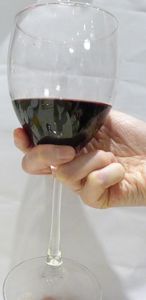Unit 10 Common Acids and Alkalis
Topic
Can acidity be changed?
Curriculum Link
10.2 Indicators for testing acids and alkalis: pH scale as an indication of relative acidity, measurement of pH value
Estimated Lesson Time
80 minutes
Introduction
The quality or taste of some drinks differs when they are placed in a different environment. Take red wine as an example, some wine tasters pay much attention to how to hold the wineglass before they drink.
 |
 |
| Figure 1 | Figure 2 |
Comparing with the way of holding the wineglass in Figure 1, the way of the holding the wineglass in Figure 2 can warm the wine slightly according to some wine tasters. This might change the taste of some wine a little bit. Obviously, the warmth of the hand affects the temperature of the wine, which in turn causes a change of the acidity of the wine and makes its taste different.
Therefore, in order to enjoy the best of a drink, it is worth investigating whether temperature affects the acidity of a drink, and how if it does.
Key Question
The taste of some drinks is related to acidity. How is acidity affected, if any, by temperature?
Learning Objectives
In this activity, the students should be able to
- recognize that solutions are classified into acidic and alkaline;
- explore how the pH value of a solution is affected by temperature (or other factors);
- acquire planning and designing skills in designing an experiment to measure pH value against temperature and proposing hypothesis before carrying out the experiment (SP3);
- acquire measuring skills and experimenting skills in measuring temperature and pH value (SP1 & SP4);
- acquire comparing and classifying skills by identifying the trend of change of the pH value for acidic and alkaline solutions (SP2);
- acquire interpreting data skills in analyzing the data collected (SP5).
Teaching Plan
| Task (Time) | Brief Description | Materials | Objectives |
|---|---|---|---|
|
Engagement |
|
|
(1) & (3) |
Exploration |
Students design set-up(s) to measure pH value against temperature and carry out the experiment
|
|
(2), (3) & (4) |
Evaluation |
Students analyze the set(s) of data to
|
(5) & (6) | |
Elaboration & Explanation |
|
(6) | |
Exploration |
|
(3) & (4) |
*Apparatus and materials required:
- thermometer
- test tubes
- pH meter
- beakers
- retort stand and clamp
- stirrer
- Bunsen burner
- safety goggles
- gloves
- solutions of different acidity


